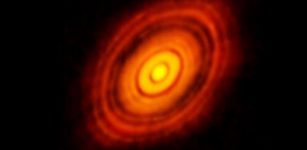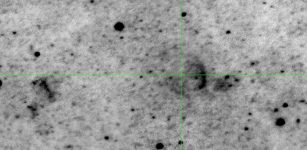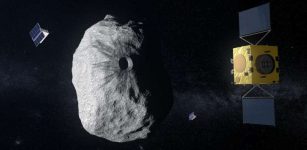Hubble Investigates A Gigantic Galaxy With Nine Rings
Eddie Gonzales Jr. – MessageToEagle.com – Hubble Space Telescope captured rhe massive galaxy LEDA 1313424 displays nine star-filled rings after a smaller blue dwarf galaxy passed through its center.
LEDA 1313424, aptly nicknamed the Bullseye, is two and a half times the size of our Milky Way and has nine rings — six more than any other known galaxy. High-resolution imagery from NASA’s Hubble Space Telescope confirmed eight rings, and data from the W. M. Keck Observatory in Hawaii confirmed a ninth. Hubble and Keck also confirmed which galaxy dove through the Bullseye, creating these rings: the blue dwarf galaxy that sits to its immediate center-left. NASA, ESA, Imad Pasha (Yale), Pieter van Dokkum (Yale)
Astronomers using Hubble identified eight visible rings, more than previously detected by any telescope in any galaxy, and confirmed a ninth using data from the W. M. Keck Observatory in Hawaii. Previous observations of other galaxies show a maximum of two or three rings.
“This was a serendipitous discovery,” said Imad Pasha, the lead researcher and a doctoral student at Yale University in New Haven, Connecticut. “I was looking at a ground-based imaging survey and when I saw a galaxy with several clear rings, I was immediately drawn to it. I had to stop to investigate it.” The team later nicknamed the galaxy the “Bullseye.”
Hubble and Keck’s observations helped identify the galaxy that moved through the Bullseye’s center—a blue dwarf galaxy. This small intruder passed through about 50 million years ago, creating ripple-like rings. A thin gas trail now connects them, though they are 130, 000 light-years apart.
“We’re catching the Bullseye at a very special moment in time,” said Pieter G. van Dokkum, a co-author of the new study and a professor at Yale. “There’s a very narrow window after the impact when a galaxy like this would have so many rings.”
Galaxies collide or barely miss one another quite frequently on cosmic timescales, but it is extremely rare for one galaxy to dive through the center of another. The blue dwarf galaxy’s straight trajectory through the Bullseye later caused material to move both inward and outward in waves, setting off new regions of star formation.
How big is the Bullseye? Our Milky Way galaxy is about 100,000 light-years in diameter, and the Bullseye is almost two-and-a-half times larger, at 250,000 light-years across.
The researchers used Hubble’s crisp vision to carefully to pinpoint the location of most of its rings, since many are piled up at the center. “This would have been impossible without Hubble,” Pasha said.
They used Keck to confirm one more ring. The team suspects a 10th ring also existed, but has faded and is no longer detectable. They estimate it might lie three times farther out than the widest ring in Hubble’s image.
Pasha also found a stunning connection between the Bullseye and a long-established theory: The galaxy’s rings appear to have moved outward almost exactly as predicted by models.
“That theory was developed for the day that someone saw so many rings,” van Dokkum said. “It is immensely gratifying to confirm this long-standing prediction with the Bullseye galaxy.”
If viewed from above, it would be more obvious that the galaxy’s rings aren’t evenly spaced like those on a dart board. Hubble’s image shows the galaxy from a slight angle.
“If we were to look down at the galaxy directly, the rings would look circular, with rings bunched up at the center and gradually becoming more spaced out the farther out they are,” Pasha explained.
Researchers believe the first two rings in the Bullseye formed quickly and expanded. The blue dwarf galaxy’s flythrough may have staggered additional ring formations, affecting the initial rings more. Individual stars’ orbits remained mostly undisturbed, but star groups “piled up” to form rings over millions of years. Gas moved outward, mixed with dust, and formed new stars, brightening the Bullseye’s rings.
More research is needed to identify stars existing before and after the blue dwarf’s “fly through.” Astronomers can now improve models predicting how the galaxy may evolve over billions of years, including the disappearance of more rings.
Although this discovery was a chance finding, astronomers can look forward to finding more galaxies like this one soon. “Once NASA’s Nancy Grace Roman Space Telescope begins science operations, interesting objects will pop out much more easily,” van Dokkum explained. “We will learn how rare these spectacular events really are.”
Written by Eddie Gonzales Jr. – MessageToEagle.com Staff Writer











